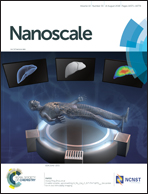A two-stage assembly with PEI induced emission enhancement of Au–AgNCs@AMP and the intrinsic mechanism†
Abstract
Recently, aggregation-induced emission (AIE) properties have been revealed for some metal nanoclusters (NCs), providing a new approach to improve the quantum yields (QY). In the present study, a two-stage assembly was carried out between adenosine monophosphate capped bimetallic nanoclusters of gold and silver (Au–AgNCs@AMP) and polyethylenimine (PEI), in which the QY was improved from 8.64% to 25.02%, showing obvious assembly induced emission enhancement (AIEE) properties. The intrinsic mechanisms of the assembly and emission enhancement in two stages were studied in depth, which indicated that the electrostatic interaction between the phosphate group in AMP and the amino group in PEI restricted the intramolecular vibration and rotation of capping ligands, and reduced the non-radiative relaxation of the corresponding excited states in stage I; in stage II, the micellization of PEI at high concentration pushed the NCs into a less polar environment and greatly enhanced the metal–metal interaction between them, which facilitated the excited state relaxation dynamics via a radiative pathway. Therefore, the luminescence enhancement depended on the assembly process in two stages directly. The present study is beneficial to understand the AIEE mechanism and the design principles, which will expand the applications of metal NCs.



 Please wait while we load your content...
Please wait while we load your content...